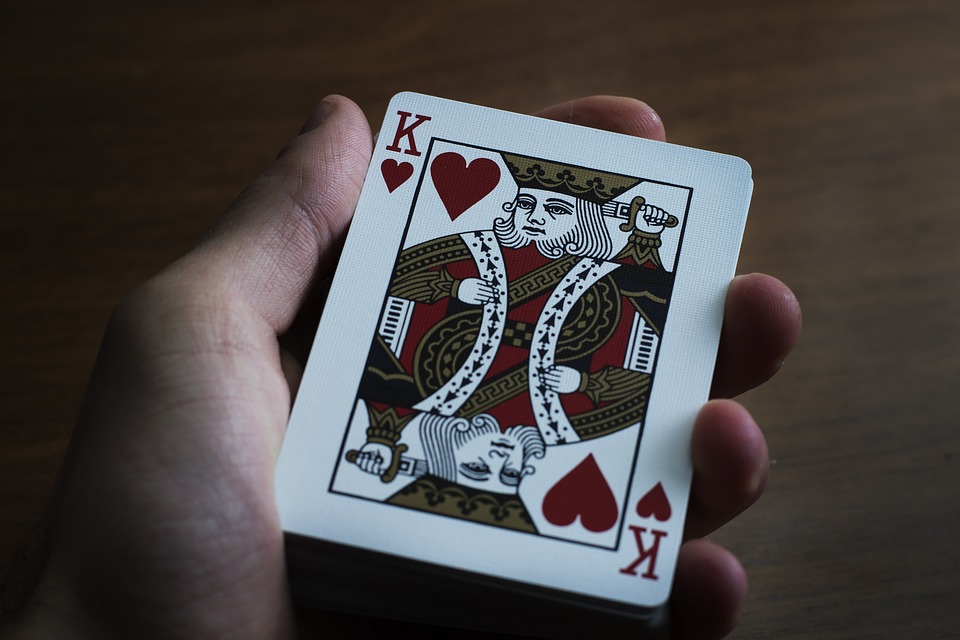
How many face cards are there in a deck of cards? There are 12 of these face cards in a deck of cards, the face cards being non-numbered cards, the King, the Queen, and Jack. There are a king, queen, and jack for each of the four different suits: hearts, spades, clubs, and diamonds.
The four suits have 13 cards each, for a total of 52 cards. Therefore, your chance of drawing a face card out of a deck of cards upon choosing the card at random is 12 out of 52, or about 23%.
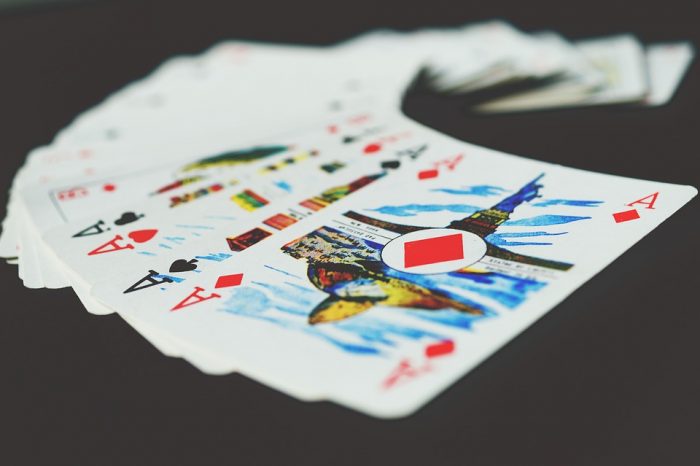
Photo: Pexels via Pixabay, CC0
What are some other interesting probabilities involving cards and other objects like dice and coins? Let’s take a look at some examples of probability calculation using cards and other common household objects.
Basic Probability With Coins
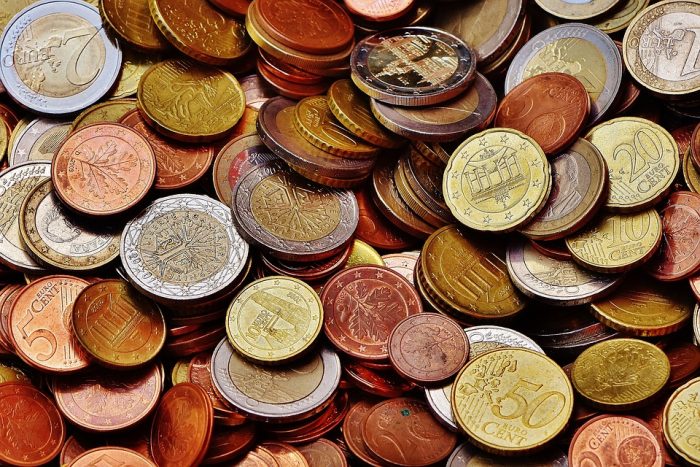
Photo: Alexas_Fotos via Pixabay, CC0
Let’s start off with a very basic probability calculation. If you flip a coin, what is the probability that it will land on heads? The probability the coin will land on heads is one out of two, one half, or 50%. This is common knowledge to pretty much everyone. Yet what is the probability that you could get two heads in a row if the coin was flipped twice in a row? To go beyond that, what is the probability that flipping a coin three times would result in three heads? What is the probability that you could get four heads in a row?
A common probability question is something like this: “Assume that you flip a coin three times and the coin comes up with heads all three times. What is the probability that the coin will land on heads again?” Remember that every flip of the coin represents an independent probability, independent meaning that the probability of the event is unaffected by any previous outcome. Therefore, the probability that the coin will come up either tails or heads is only affected by the toss of the coin itself.
The answer to the above question will always be 50% or one-half. The probability of the coin toss is never affected by previous coin tosses, the coin has no “desire” to come up a certain way. The assumption that the coin is more likely to come up head/tails, or that an outcome in a series of independent probabilities is more likely simply because one is “on a roll”, is sometimes referred to as the Gambler’s Fallacy.
Another common probability question may be a variation on the following: “If you flip four coins, what is the probability that all four coins will come up tails?” This situation is different from the above one, as you are looking for joint probability. While the probability of one coin flip still isn’t affected by the probability of another flip, one event must occur as well as other events, making this an “and” situation. What is the probability that you will get tails AND another tails three more times? When you are trying to determine the probability of an “and” situation you must multiply the probabilities together.
Since every individual flip has a probability of ½, you can determine the probability like this:
½ x ½ x ½ x ½ = 1/16
What if you had to determine the probability that heads would come up twenty times in a row if you flipped the coin 20 times? Just like the simpler example above, there is an “AND” condition for each of the 20 different flips.
This probability can be expressed as ½ x N, where N is the number of individual coin flips.
Carrying this multiplication out all the way would show you that the probability of getting heads on twenty coin flips in a row is extremely small, roughly one in a million. However, if we took every person in the United States and had them flip one coin 20 times in a row, a fair number of them would actually succeed in getting twenty heads. This would be because of the vast number of people flipping coins. Remember that no matter how unlikely an event, there are millions of event taking place every day. We simply pay attention to the events that are relevant to us. Keep this in mind next time you encounter an unlikely coincidence.
Probability Examples With Dice
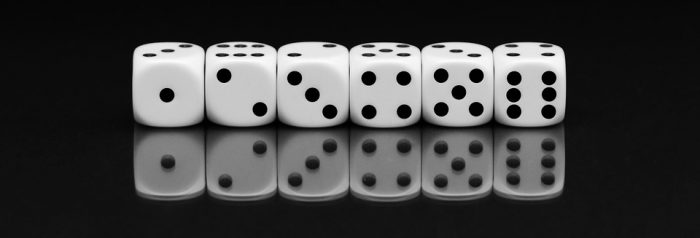
Photo: annca via Pixabay, CC0
Let’s take a look at calculating probabilities with dice now. Let’s figure out what the probability of a specific side coming up on a dice cube is. The probability of a side of any given side on a die coming up is one out of six since there are six sides on a die. Remember that the probability of an event like this is just the number of desired outcomes divided by the number of possible outcomes. So the odds of any given side of a die coming up is like this:
Probability = ⅙ = 0.167
When written in terms of a decimal like this, probability 0 is no chance of the event happening while a probability of 1 guarantee that the event will happen. If you would like to have this probability as a percentage rather than as a decimal, you just need to convert it by dividing the denominator of the fraction by the numerator. When given like this, the chance of rolling any given side is 16.7%.
Given the probability of rolling a single side on a die, what would the probability of rolling two sixes in a row be? The probability of rolling two sixes in a row is 2.78%, as calculated by doing this:
1/6 x ⅙ = 1/36
And now divide the fraction 1/36. Divide 36 into 1 to get 0.0278, or expressed as a percentage – 2.78%. If you wanted to know the probability that you would get a specific number/score by rolling two or more dice, the probability could be determined using the same basic formula.
However, the calculations become more complicated as you need to account for the different possible ways of achieving the total number you are interested in. As an example, if you are trying to get the probability of getting a 4 when rolling two dice, you could achieve this by rolling a three and a one or two twos. If you consider rolling a one and a three different than rolling a three and a one, you’ll also have to account for both outcomes separately.
Probability Examples With Cards
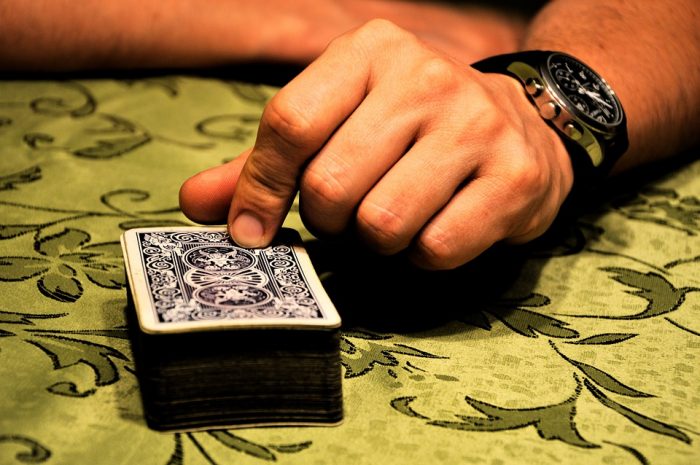
Photo: tookapic via Pixabay, CC0
Why are people impressed when they see a magician correctly guess which out of a deck of 52 cards a volunteer has picked? They are impressed because, as mentioned above, the magician only has a one in 52 chance of guessing correctly if they are just as. This means that the that they would correct if making a random guess is slightly less than 2%. In other words, they could make 100 guesses and guess the correct card only twice.
And if a magician would try to correctly guess two cards in a row, the probability of doing so becomes substantially smaller. The first guess has only a one in 52 chance of being correct while the second-guess a slightly higher one and 51 chance of being correct. In order to determine the ability of correctly guessing two cards in a row, multiply the results together:
1/52 x 1/51 = 1/2652 ≈ 0.0004
As you can see, the probability of correctly guessing two cards in a row is vanishingly small. Because of this, magicians use tricks like sleight-of-hand to rig the deck in such a way that they can control which cards come up.
Multiplying 1/52 x 1/51 demonstrates the multiplication principle, which is that the probability of any two independent events can be discerned by multiplying the two individual product probabilities together. Therefore, the probability of identifying three cards in a row with removal is simply this:
1/52 x 1/51 x 1/50 = 1/132600 ≈ 000000.8.
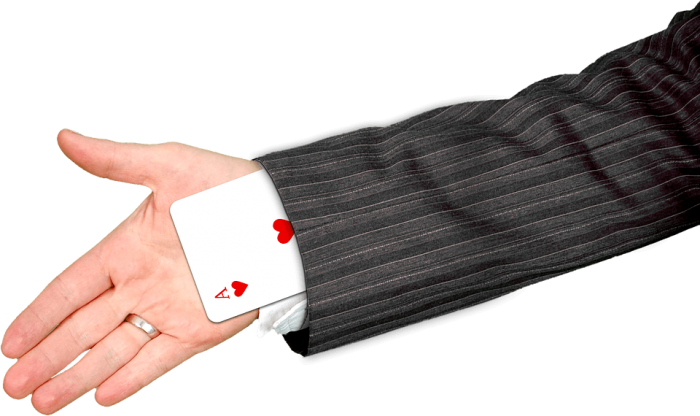
Photo: geraltvia Pixabay, CC0
If you are interested in the probability of correctly guessing three cards in a row when replacing the cards, you would multiply one out of 52 three times. The multiplication principle can be used to multiply the probability of any number of independent events occurring in a sequence. For instance, if you were interested in determining the probability that a randomly shuffled deck of cards contains a unique sorting sequence of cards, you would multiply out the permutations of the cards, beginning with 52 all the way down to 1. So the multiplication would look something like this:
52 x 51 x 50 x 49 x 48 x 47 x 46 … x 2 x 1
The result of this multiplication is = 8.07 x 10^67 – which is the probability that the order of the cards you have shuffled has occurred before. The exponent that comes after the 10 is reflective of a 10 with 66 zeros after it, and if you wrote out the phone number it would be 68 digits long. With such a small probability, it is virtually certain that the cards you are holding are in a unique order, which has never occurred before in history.








